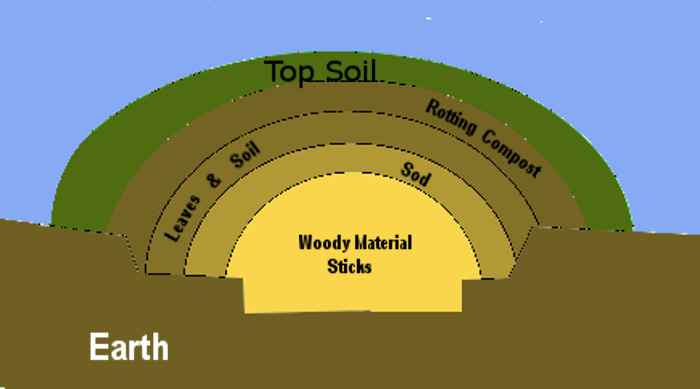Hügelkultur!

The mounds are similar in appearance to regular row till mounds commonly associated with modern agriculture, but the Hügelkultur mounds tend to be much broader and taller. The simularities end there however. Hügelkultur mounds or rows consist of more than just dirt. They are built in layers and truthfully there is not a single standard blueprint for building one, just as most house plane vary. Yet, the concept remains the same regardless of the variation in design.
A basic Hügelkultur mound is constructed of various components. Decaying wood is one component, green vegetation, sod, soil are others. Before we get into how to construct one, let's talk about the theory behind it all. The theory is as follows you start with larger diameter decaying wood and put layers of sod, leaves and soil, rotting compost all covered with top soil. The theory is that you have progressive layers of decaying material that decays at different rates. The mounds are designed to last for year and get progressively better and better soil richer and richer in organic matter as the different layers decay.
Along with lots of decaying matter providing nutrients to your plants the copious amounts of varying stages of organic matter also greatly increase water retention times and water holding capacity. All of these are of great benefit to the garden, and especially good for a primative garden that might be neglected more than a typical home garden with a water supply always readily available.
Yet another benefit of the copious amount of decaying matter is the warmth that it adds to the soil. Basically this cannot only aid in the breaking down of the organic matter, but can also help protect the plants from adverse weather conditions.
Construction of your bed or mounds or often rows starts by digging a depression. This depression servers two purposes. One it provides you with soil for the construction and two, it provides a below ground area for the first layer of the mounds which is desirable because it will help keep the bed/mound from drying out as easily and provides a buffer for your mound from the outside temperatures.
The first layer to be placed in the mound is big diameter wood. This can be large diameter wood of over a foot in diameter. Although this layer can be deleted completely from construction doing so greatly reduces the longevity of the mound. These mounds should be productive for many years, not just a single season. And actually they tend to get better with each successive year for a while.
It is extremely important to note that the wood in this layer must be already under going some degree of decay. If you were to use a freshly cut down tree then the decay of that wood would end up starving the rest of the mound of nitrogen as the bacteria trying to start the woods decay would be consuming nitrogen instead of supplying it to the bed.
The second layer is sod. Even if not tradition sod like for your lawn this layer is still important and can even be just pulled weeds. Possibly what was growing over the area where the Hügelkultur bed is now being built. A bit of soil on the roots is fine and no extra work to remove the soil should be done.
Over this layer is thrown a mixture of leaves and soil. The leaves can be either brown or green.
Over that layer another layer is made that consist of composted matter aka any plants that are in advanced stages of decay.
This mound is now covered with dirt and left for a few months to let the fungal and bacterial colonies to get established and for any green materials a chance to begin the decomposition process.
Of course there are many variations and this recipe does not have to be followed exactly. For example, the use of very large woody material can be omitted. Understand that this will mean the mound will lose its long-term ability to release nutrients to any planted crops and will need to be rebuilt more frequently. So a six year lifespan of a mound using big diameter wood will be shortened to a maybe only a couple of years.
Keep in mind that depending on the materials used and your local climate it is possible that the smaller material are used up before the larger materials have a chance to really start supplying large amounts of nitrogen and nutrients to the garden. If this is the case you will see the mound start of being quite productive, but then yields will decline. Investigation reveals a lack of decaying material. It is quite possible that left alone the mound would yield better results a year later. To avoid these dips in productivity supplemental additions of decaying organic matter will need to be added.
This actually defeats the goal of having a continued supply of decaying organic matter year after year without the need to disrupt the bacterial colonies to add the new material. Add the new material as needed but in the future try to add more intermediate materials to the original build so that this nutrient gap is bridged without the sharp fall off in production.
